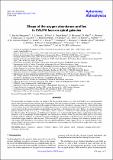Shape of the oxygen abundance profiles in CALIFA face-on spiral galaxies
Abstract
We measured the gas abundance profiles in a sample of 122 face-on spiral galaxies observed by the CALIFA survey and included all spaxels whose line emission was consistent with star formation. This type of analysis allowed us to improve the statistics with respect to previous studies, and to properly estimate the oxygen distribution across the entire disc to a distance of up to 3-4 disc effective radii (re). We confirm the results obtained from classical H ii region analysis. In addition to the general negative gradient, an outer flattening can be observed in the oxygen abundance radial profile. An inner drop is also found in some cases. There is a common abundance gradient between 0.5 and 2.0 re of αO/H =-0.075 dex/re with a scatter of σ = 0.016 dex/re when normalising the distances to the disc effective radius. By performing a set of Kolmogorov-Smirnov tests, we determined that this slope is independent of other galaxy properties, such as morphology, absolute magnitude, and the presence or absence of bars. In particular, barred galaxies do not seem to display shallower gradients, as predicted by numerical simulations. Interestingly, we find that most of thegalaxies in the sample with reliable oxygen abundance values beyond ~2 effective radii (57 galaxies) present a flattening of the abundance gradient in these outer regions. This flattening is not associated with any morphological feature, which suggests that it is a common property of disc galaxies. Finally, we detect a drop or truncation of the abundance in the inner regions of 27 galaxies in the sample; this is only visible for the most massive galaxies.
Citation
Sánchez-Menguiano , L , Sánchez , S F , Pérez , I , Garciá-Benito , R , Husemann , B , Mast , D , Mendoza , A , Ruiz-Lara , T , Ascasibar , Y , Bland-Hawthorn , J , Cavichia , O , Diáz , A I , Florido , E , Galbany , L , Gónzalez Delgado , R M , Kehrig , C , Marino , R A , Márquez , I , Masegosa , J , Méndez-Abreu , J , Mollá , M , del Olmo , A , Pérez , E , Sánchez-Blázquez , P , Stanishev , V , Walcher , C J , López-Sánchez , A R & collaboration the CALIFA 2016 , ' Shape of the oxygen abundance profiles in CALIFA face-on spiral galaxies ' , Astronomy & Astrophysics , vol. 587 , A70 , pp. 1-21 . https://doi.org/10.1051/0004-6361/201527450
Publication
Astronomy & Astrophysics
Status
Peer reviewed
ISSN
0004-6361Type
Journal article
Description
Y.A. acknowledges financial support from the Ramón y Cajal programme (RyC-2011-09461). Y.A. and A.I.D. acknowledge support from the project AYA2013-47742-C4-3-P from the Spanish MINECO, as well as the “Study of Emission-Line Galaxies with Integral-Field Spectroscopy” (SELGIFS) programme, funded by the EU (FP7-PEOPLE-2013-IRSES-612701). Support for L.G. is provided by the Ministry of Economy, Development, and Tourism’s Millennium Science Initiative through grant IC120009, awarded to The Millennium Institute of Astrophysics, MAS. LG acknowledges support by CONICYT through FONDECYT grant 3140566. R.M.G.D. acknowledges support from the Spanish grant AYA2014-57490-P, and from the “Junta de Andalucía” P12-FQM2828 project. RAM thanks the Spanish program of International Campus of Excellence Moncloa (CEI). IM and A.d.O. acknowledge support from the Spanish MINECO grant AYA2013-42227P. JMA acknowledges support from the European Research Council Starting Grant (SEDmorph, P.I. V. Wild). Support for MM has been provided by DGICYT grant AYA2013-47742-C4-4-P. PSB acknowledges support from the Ramón y Cajal programme, grant ATA2010-21322-C03-02 from the Spanish MINECO. CJW acknowledges support through the Marie Curie Career Grant Integration 303912.Collections
Items in the St Andrews Research Repository are protected by copyright, with all rights reserved, unless otherwise indicated.
Related items
Showing items related by title, author, creator and subject.
-
SDSS-IV MaNGA: How the stellar populations of passive central galaxies depend on stellar and halo mass
Oyarzún, Grecco A.; Bundy, Kevin; Westfall, Kyle B.; Tinker, Jeremy L.; Belfiore, Francesco; Argudo-Fernández, Maria; Zheng, Zheng; Conroy, Charlie; Masters, Karen L.; Wake, David; Law, David R.; McDermid, Richard M.; Aragón-Salamanca, Alfonso; Parikh, Taniya; Yan, Renbin; Bershady, Matthew; Sánchez, Sebastián F.; Andrews, Brett H.; Fernández-Trincado, José G.; Lane, Richard R.; Bizyaev, D.; Boardman, Nicholas Fraser; Lacerna, Ivan; Brownstein, J. R.; Drory, Niv; Zhang, Kai (2022-07-06) - Journal articleWe analyze spatially resolved and co-added SDSS-IV MaNGA spectra with signal-to-noise ratio ∼100 from 2200 passive central galaxies (z ∼ 0.05) to understand how central galaxy assembly depends on stellar mass (M*) and halo ... -
Secular-and merger-built bulges in barred galaxies
Mendez Abreu, Jairo; Debattista, V. P.; Corsini, E. M.; Aguerri, J. A. L. (2014-12) - Journal articleContext. Historically, galaxy bulges were thought to be single-component objects at the center of galaxies. However, this picture is now questioned since different bulge types with different formation paths, namely classical ... -
Galaxy And Mass Assembly (GAMA) : galaxy close pairs, mergers and the future fate of stellar mass
Robotham, A. S. G.; Driver, S. P.; Davies, L. J. M.; Hopkins, A. M.; Baldry, I. K.; Agius, N. K.; Bauer, A. E.; Bland-Hawthorn, J.; Brough, S.; Brown, M. J. I.; Cluver, M.; De Propris, R.; Drinkwater, M. J.; Holwerda, B. W.; Kelvin, L. S.; Lara-Lopez, M. A.; Liske, J.; Lopez-Sanchez, A. R.; Loveday, J.; Mahajan, S.; McNaught-Roberts, T.; Moffett, A.; Norberg, P.; Obreschkow, D.; Owers, M. S.; Penny, S. J.; Pimbblet, K.; Prescott, M.; Taylor, E. N.; van Kampen, E.; Wilkins, S. M. (2014-11-11) - Journal articleWe use a highly complete subset of the Galaxy And Mass Assembly II (GAMA-II) redshift sample to fully describe the stellar mass dependence of close pairs and mergers between 10(8) and 10(12)M(circle dot). Using the analytic ...

